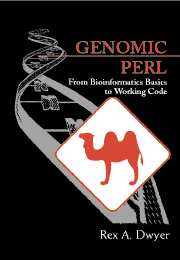Book contents
- Frontmatter
- Contents
- Preface
- Acknowledgments
- 1 The Central Dogma
- 2 RNA Secondary Structure
- 3 Comparing DNA Sequences
- 4 Predicting Species: Statistical Models
- 5 Substitution Matrices for Amino Acids
- 6 Sequence Databases
- 7 Local Alignment and the BLAST Heuristic
- 8 Statistics of BLAST Database Searches
- 9 Multiple Sequence Alignment I
- 10 Multiple Sequence Alignment II
- 11 Phylogeny Reconstruction
- 12 Protein Motifs and PROSITE
- 13 Fragment Assembly
- 14 Coding Sequence Prediction with Dicodons
- 15 Satellite Identification
- 16 Restriction Mapping
- 17 Rearranging Genomes: Gates and Hurdles
- A Drawing RNA Cloverleaves
- B Space-Saving Strategies for Alignment
- C A Data Structure for Disjoint Sets
- D Suggestions for Further Reading
- Bibliography
- Index
1 - The Central Dogma
Published online by Cambridge University Press: 05 June 2012
- Frontmatter
- Contents
- Preface
- Acknowledgments
- 1 The Central Dogma
- 2 RNA Secondary Structure
- 3 Comparing DNA Sequences
- 4 Predicting Species: Statistical Models
- 5 Substitution Matrices for Amino Acids
- 6 Sequence Databases
- 7 Local Alignment and the BLAST Heuristic
- 8 Statistics of BLAST Database Searches
- 9 Multiple Sequence Alignment I
- 10 Multiple Sequence Alignment II
- 11 Phylogeny Reconstruction
- 12 Protein Motifs and PROSITE
- 13 Fragment Assembly
- 14 Coding Sequence Prediction with Dicodons
- 15 Satellite Identification
- 16 Restriction Mapping
- 17 Rearranging Genomes: Gates and Hurdles
- A Drawing RNA Cloverleaves
- B Space-Saving Strategies for Alignment
- C A Data Structure for Disjoint Sets
- D Suggestions for Further Reading
- Bibliography
- Index
Summary
DNA and RNA
Each of us has observed physical and other similarities among members of human families. While some of these similarities are due to the common environment these families share, others are inherited, that is, passed on from parent to child as part of the reproductive process. Traits such as eye color and blood type and certain diseases such as red–green color blindness and Huntington's disease are among those known to be heritable. In humans and all other nonviral organisms, heritable traits are encoded and passed on in the form of deoxyribonucleic acid, or DNA for short. The DNA encoding a single trait is often referred to as a gene. Most human DNA encodes not traits that distinguish one human from another but rather traits we have in common with all other members of the human family. Although I do not share my adopted children's beautiful brown eyes and black hair, we do share more than 99.9% of our DNA. Speaking less sentimentally, all three of us share perhaps 95% of our DNA with the chimpanzees.
DNA consists of long chains of molecules of the modified sugar deoxyribose, to which are joined the nucleotides adenine, cytosine, guanine, and thymine. The scientific significance of these names is minimal – guanine, for example, is named after the bird guano from which it was first isolated – and we will normally refer to these nucleotides or bases by the letters A, C, G, and T. For computational purposes, a strand of DNA can be represented by a string of As, Cs, Gs, and Ts.
- Type
- Chapter
- Information
- Genomic PerlFrom Bioinformatics Basics to Working Code, pp. 1 - 15Publisher: Cambridge University PressPrint publication year: 2002

